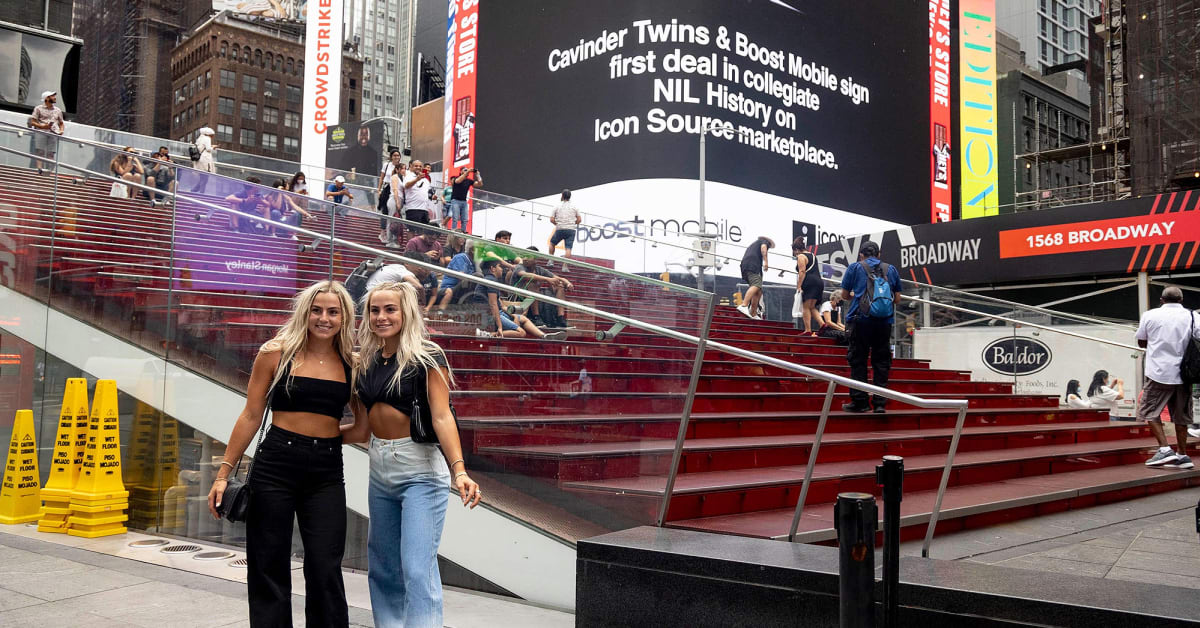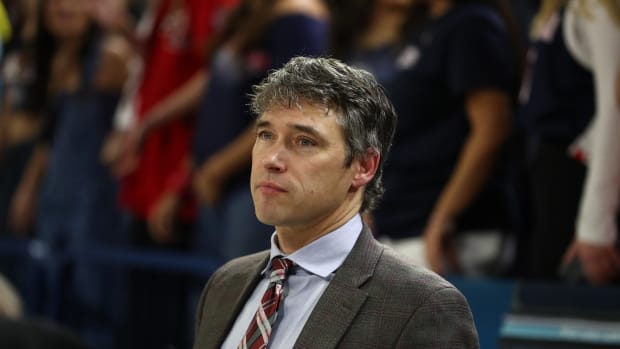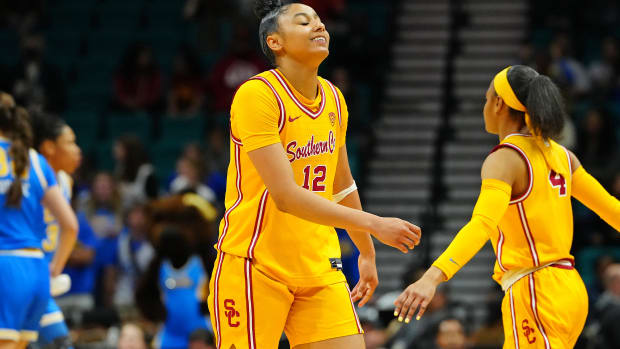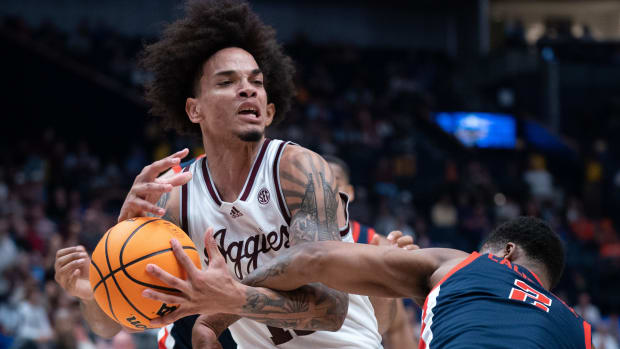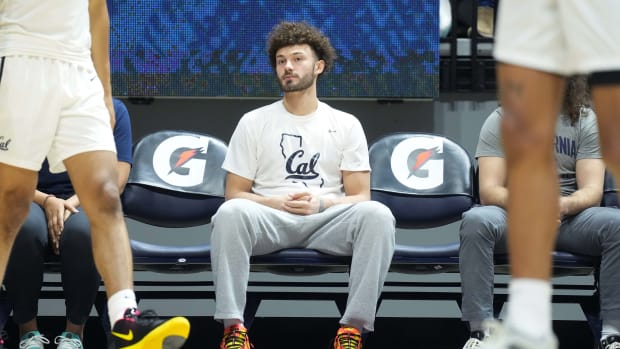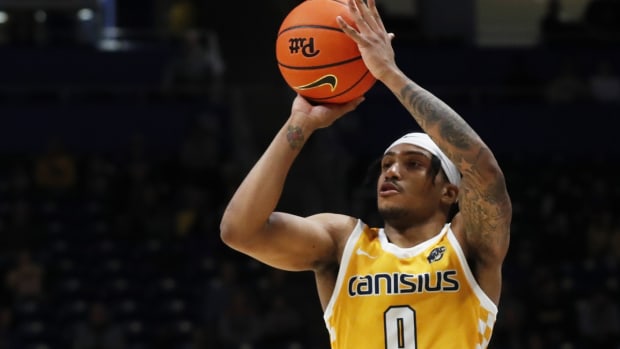NCAA Issues First NIL Ruling, With Cavinder Twins at the Center of It
The NCAA issued its first ruling in a name, image and likeness infractions case Friday, wading into what until now had been uncharted waters in terms of rules enforcement. While a head coach was suspended and other minor institutional penalties assessed, an involved booster escaped sanctions—an outcome that left the Committee on Infractions itself conflicted.
A case involving Miami women’s basketball players Haley and Hanna Cavinder reached a negotiated resolution that resulted in a three-game suspension for Hurricanes coach Katie Meier, which she served at the beginning of the 2022-23 season. The Cavinder twins, who are social media sensations with a vast following, were not sanctioned—which is consistent with the NCAA’s stance that it does not plan to penalize athletes themselves for NIL-adjacent infractions.
Perhaps most significantly, prominent Miami booster John Ruiz, who violated rules by contacting the Cavinders and providing an impermissible meal, was not disassociated from the program. The penalty, even absent a dissociation, was reluctantly approved by the Committee on Infractions, which often is charged with assessing penalties. However, this case was a negotiated resolution between the school and NCAA Enforcement, which left the COI in a position of either accepting or rejecting the outcome. It chose to accept, but expressed its reservations in an unusual preamble to the case synopsis.
“The investigation did not develop any facts directly linking activities around name, image and likeness to the prospects’ recruitment to or decision to enroll at the University of Miami,” the COI wrote in its report. “During its review, however, the panel was troubled by the limited nature and severity of institutional penalties agreed upon by Miami and the enforcement staff—namely, the absence of a disassociation of the involved booster. …
“Although the parties asserted that a disassociation penalty would be inappropriate based on an impermissible meal and an impermissible contact, today’s new NIL-related environment presents a new day. Boosters are involved with prospects and student-athletes in ways the NCAA membership has never seen or encountered. In that way, addressing impermissible booster conduct is critical, and the disassociation penalty presents an effective penalty available to the COI.”
With that as context, Committee on Infractions chief hearing officer Gary Miller told Sports Illustrated that this Miami ruling shouldn’t be viewed as precedent going forward. He says the COI sent the resolution letter back to NCAA Enforcement and Miami seeking clarifications before signing off on it. The COI, Miller says, will take a hard look at booster behaviors and ways to curb booster-related infractions.
“What the NIL thing has done, it’s introduced a completely different sphere of potential conduct that we’re concerned about,” Miller says. “We just want to make sure that the membership and athletic departments and boosters know that there is a concern, and will be a concern, about booster conduct in the NIL space.”
Adds COI chair Dave Roberts: “I think [the wording that went with this ruling] is a pretty good stop sign, that you’d better be thinking before you do something and run afoul. We’re not telling [boosters] we’re going to slam you, but don’t take this as precedent that it will never happen.”
Despite the relatively mild penalties, the Cavinder twins’ case is significant in that it serves as the NCAA’s first infractions ruling in an NIL-related matter. For months, the college sports world has waited for guidance into this new territory from the governing body. Many have wanted the NCAA to investigate, prosecute and penalize programs for violations in this new NIL era, where boosters and booster-led collectives are supplying millions to college athletes and promising millions to college prospects. Others have simply wanted clarity on what the NCAA will pursue. At the very least, this ruling is the start of a road map into a new realm.
The association first targeted Ruiz, a billionaire booster who has paid millions of dollars in NIL-related cash to more than 100 athletes, many of them from Miami. One of the more publicly brash figures in the NIL world, Ruiz has brazenly announced NIL deals on social media even before athletes have signed with the university.
In an ironic twist, it was a tweet from Ruiz in April 2022 that drew the NCAA to this case. While in the transfer portal, Haley and Hanna Cavinder, as well as their parents, dined with Ruiz at his Miami home on April 13. That night, Ruiz posted a photo of the group posing in front of his home on his Twitter feed.
The meeting was in violation of several NCAA recruiting rules. The association describes it as “impermissible contact,” and the chef-prepared dinner provided by Ruiz is classified as a recruiting “inducement.” Though these rules have become murky since the NIL era launched on July 1, 2021, boosters are prohibited from associating with prospects or providing them improper benefits. That’s a point the committee wanted to make: The NCAA is still in the business of rules enforcement even in the changing landscape of player compensation from boosters.
“Boosters can’t help recruit, and they certainly can’t give inducements,” Roberts says.
Meier was cited for violating “head-coach responsibility,” as text messages from Meier to Ruiz show the coach facilitated the meeting between the booster and the Cavinders.
After they first met last spring at an athletic event, Ruiz and Meier began exchanging messages about the recruitment of the Cavinders. Ruiz texted the coach saying he was “here to help” and wanted “women’s [basketball] to be huge for UM.”
Meier later connected Ruiz with the family and the Cavinders’ agent, who, according to the NCAA, had already communicated with Ruiz.
In addition to Meier’s three-game suspension, the NCAA penalized Miami women’s basketball with the following:
- A one-year probation, which could result in more severe sanctions if the program violates rules during that time.
- A $5,000 fine plus 1% of the women’s basketball budget.
- A 7% reduction in the number of official visits during the 2022–23 academic year.
- A reduction of nine recruiting days in 2022–23.
- A three-week probation on recruiting communications by staff members starting with the opening of the transfer portal on March 13.
The penalties might have been more severe had the case been processed after the NCAA lowered its violation standard, which took effect Jan. 1. The change has strengthened the enforcement staff’s ability to charge schools with violations, allowing investigators more leeway in presuming an NIL-related violation occurred. They can now use circumstantial evidence, like a tip or a news story, to presume a school violated NCAA rules instead of having to ascertain on-record sourcing. The Cavinders’ case was processed under the previous policy.
The Cavinder twins, by which they often refer to themselves, have earned an estimated seven figures in NIL deals since the NCAA lifted its amateurism rules. Their NIL efforts are rooted in a massive social media following that developed during the COVID-19 pandemic, when the two women created videos of themselves dancing. They combine for more than five million followers on TikTok and Instagram.
The estimated annual gross income for a social media influencer is about 80 cents per follower, according to one advertising standard. That’s more than $3 million in deals annually. Recent posts on their social channels show the Cavinders posing for photos in an assortment of settings—in their Miami basketball jerseys on the court, in two-piece swimsuits at a rooftop pool and in evening gowns outside of a stately home.
Haley Cavinder leads the Hurricanes in scoring at 12.8 points per game, while Hanna is averaging 3.8 points. Miami is 17–10 overall this season and tied for sixth place in the Atlantic Coast Conference with a 10–6 record in conference play.
The investigation into the Cavinders went somewhat under the radar, overshadowed by another Miami basketball case involving Ruiz and another transferring player: Nijel Pack. Pack transferred from Kansas State to Miami last spring. In a single tweet, Ruiz announced Pack’s commitment to the Canes, as well as a two-year, $800,000 deal he struck with the player to endorse Ruiz’s two companies, LifeWallet, a health care application, and the Cigarette (boat) Racing Team.
The tweet drew more than five million impressions, something Ruiz has used to point to an early return on his investment. The post also had the figurative jaws of college sports dropping to the floor, with critics pointing to the brashness of such a move and the dollar figures. Roughly a month later, NCAA investigators arrived in Miami for what was believed to be the first serious inquiry into a college athletic department since the association lifted rules that once prohibited athletes to earn compensation from their likeness.
Interestingly, the Pack contract Ruiz promoted was not part of the resolution of this case. COI members said the only infractions that were presented by Enforcement and the university pertained to the Cavinders and the Miami women’s basketball program. Pack is one of the leaders of a Hurricanes men’s team that leads the ACC with a 23–5 overall record, 14–4 in league play.
Ruiz, an ardent supporter of Miami athletics whose three children attended the school, has spent more than $10 million on NIL. He has continuously stated he is abiding by the NCAA’s NIL policy with all his deals.
“We feel our platform is the only one in the country that truly would be resilient to any attack by the NCAA,” he told SI last summer. “A majority of people don’t understand the law. Their first reaction is, ‘If it’s not my team, it’s no good!’ The reality is there is a quid pro quo.”
Across the country, thousands of college football boosters are pooling donations through third-party entities, NIL collectives, that distribute the money mostly to their school’s football and basketball players.
Figures vary greatly. But at the Power 5 level, most elite collectives contend they are distributing $3 million to $5 million annually to students in their schools’ athletic departments. A small group of elite players, mostly quarterbacks, are making seven figures, while another portion of high-level starters are pulling in low six figures. The vast majority of Power 5 football players are earning less than $100,000, and a baseline of $25,000 to $75,000 has emerged, experts say.
High-level administrators have quite blunt about what is transpiring, many of them outright referring to NIL as “pay-for-play,” something that defies NCAA rules.
At the NCAA convention last month, Mark Hicks, the association’s managing director of enforcement, described collectives as nothing more than “booster clubs.” Hicks says NCAA enforcement officials hear often from coaches and administrations about being approached by “NIL agents” in recruiting who often quote money figures for a prospect and say, “If you think you can play in that ballpark, then we'd like to be a part of the recruiting process.”
In a sign of its aggressive approach to NIL, the NCAA has bulked up an enforcement staff that was, at one point, down as much as 20 personnel compared to pre-COVID-19 levels. It has also recently hired an associate director of enforcement specifically overseeing NIL inquiries. Derrick Coles left the A-Sun to take that role earlier this month. Meanwhile, the organization hired Craig Moringiello as an assistant director of enforcement last fall. Moringiello’s addition is of interest as he formerly worked for the FBI and CIA, with expertise in cybersecurity and counterintelligence.
Jon Duncan, the NCAA vice president of enforcement, told administrators at the convention that association officials have closed several NIL-related cases (without penalties) and have several active cases.
More infractions results, such as the Cavinders’ case, are expected in the coming months.
“My understanding is that a hell of a lot of these collectives are absolutely [offering] inducements,” Roberts says. “The question is, is Enforcement going to take up these cases, and can they get the information, the evidence, to bring those [cases] to us? If the evidence can be found, we’re going to have a lot more cases.”
